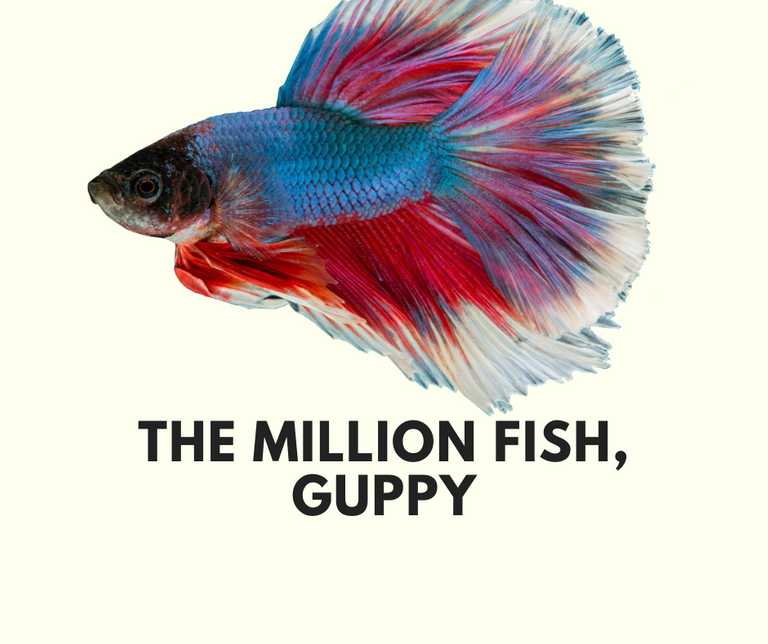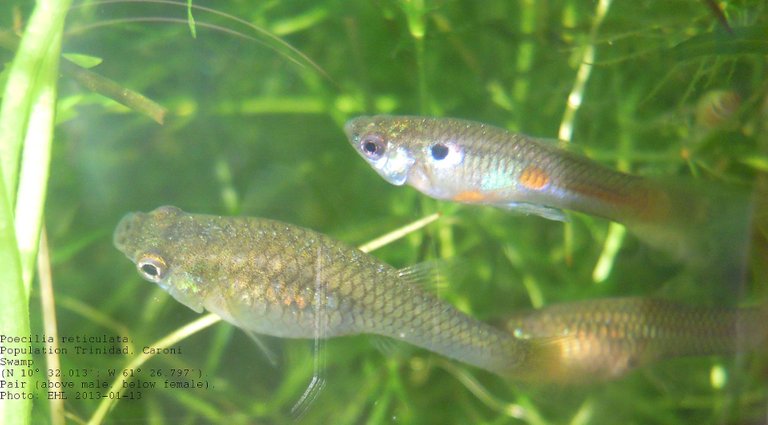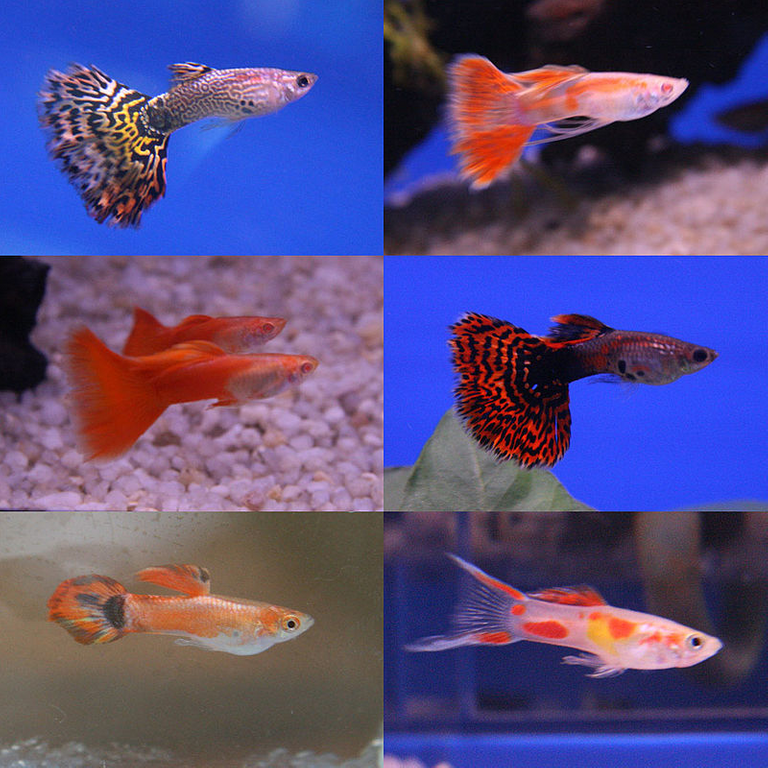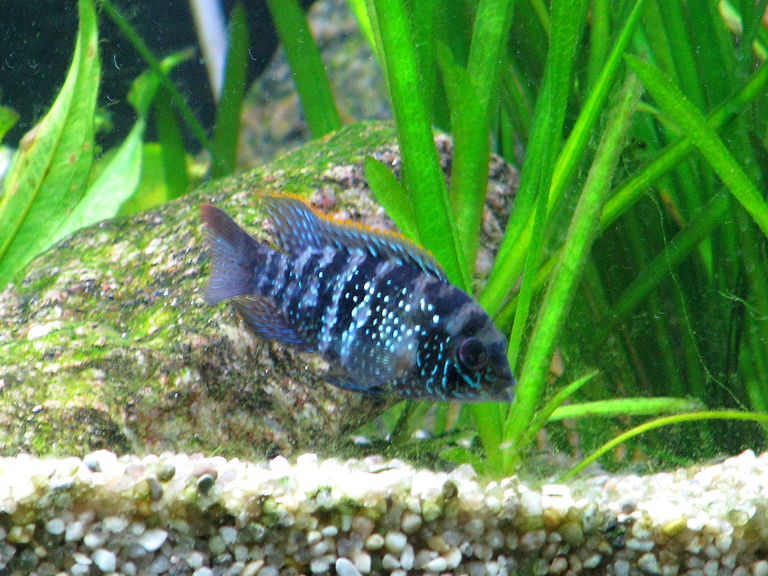The Million Fish, Guppy

The guppy, also known as million fish or rainbow fish, is a common freshwater aquarium fish and one of the world's most widely distributed tropical fish. It belongs to the Poeciliidae family, and like almost all American members of the family, bears live young. Guppies are native to northeastern South America, but it adapts to several habitats across the world. They are adaptable that allows the guppies to thrive in a wide range of environmental and ecological environments. Male guppies have ornamental caudal and dorsal fins, which are smaller than females. Guppies eat several foods in the wild such as benthic algae and aquatic insect larvae. Antigua and Barbuda, Barbados, Brazil, Guyana, Jamaica, the Netherlands Antilles, Trinidad and Tobago, the US Virgin Islands, and Venezuela are home to guppies.
Guppies are in every country on every continent except Antarctica. Strangely, people used guppies as a form of mosquito control, which happened by mistake on occasion. People used guppies to consume mosquito larvae to help slow the spread of malaria, but it has a detrimental effect on native fish stocks in many cases. Guppies are notorious for colonizing almost every freshwater body accessible to them in their natural ranges, especially in streams near the coast of South America. Guppies can tolerate brackish water, which enables them to populate some brackish habitats. It has a larger population in shallow streams and pools than deeper or faster-flowing rivers. It acclimated to complete saltwater and used to cycle saltwater aquariums, similar to their molly relatives.

Sexual polymorphism exhibited in the Trinidadian guppy (above male, below female)
We can detect sexual dimorphism in guppies. Males have splashes, spots, or stripes that may be any colors, while females are gray. Guppies come in several sizes, but males are usually 1.5–3.5 cm (0.6–1.4 in) long, while females are 3–6 cm (1.2–2.4 in). Breeders create a range of guppy strains with various colors, patterns, forms, and sizes of fins, such as snakeskin and grass types, through selective breeding. Many domestic guppies exhibit morphological characteristics that differ significantly from their wild-type ancestors. They have larger bodies, which are more ornamental than their wild-type ancestors. Guppies have the same number of chromosome pairs as humans, plus one pair of sex chromosomes. The ornamentation genes in male guppies are related to the Y-chromosome.
In the wild, there are two to three generations of guppies each year. By the time they are born, guppies fully grow to become capable of living without the assistance of their parents. Young guppies go to school together and practice anti-predator techniques. Brood size varies greatly across populations, but some differences are depending on predation levels and other factors. In high-predation situations, females with similar body sizes produce more offspring but small sizes. Female guppies begin reproducing at 10–20 weeks of age and continue to do so until they are 20–34 months old. Male guppies mature in around seven weeks. Guppies' total lifespan in the wild varies a lot, but it's usually about two years. Variations in guppies' life histories have been found in various populations, suggesting that different evolutionary forces are at work.

Different bred of guppies
Guppies' body sizes increase with age, and their mature size varies greatly depending on the predation risk of its environment. Male and female guppies from high-predation areas mature faster and begin reproducing earlier than those at the low-predation section. Females in high-predation areas are fertile than in low-predation, which allows them to produce more offspring. Age affects female guppies in reproducing offspring. Older female guppies have smaller offspring with longer interbreed cycles.
The senescence patterns observed in wild guppies are due to the mortality rate attributed to predation. In high-predation areas, guppies have a higher extrinsic mortality rate because predators are more likely to kill them. Female guppies have a significant increase in mortality at six months of age in the high-predation area. In contrast, guppies have lower mortality until they are 16 months old in the low-predation areas. Besides, guppies exposed to the high-predation environment have longer lifespans due to their longer reproductive lifespans. There is no discernible difference in post-reproductive lifespans.

Aequidens pulcher (Blue acara) is a common predator of guppies
Resource availability and density, in addition to senescence patterns, play a role in guppy population control. In response to a lack of food, guppies decrease their fecundity and reproductive allocation. When food is plentiful, they expand their brood size. Seasonality of life-history characteristics in certain guppy species may be due to differential reproductive allotment. Guppies in the Northern Range of Trinidad, for example, reduce their investment in reproduction during the wet season, from May to December, regardless of predation levels, likely in response to reduced food supplies. An increase in intraspecific rivalry caused a decrease in reproductive and somatic growth rates. We can associate juvenile mortality rate due to cannibalism. We can control the guppy populations by density in low-predation conditions, according to a recent study.
Polyandry is a mating mechanism used by guppies, in which females pair with several males. Males benefit from multiple mating because their reproductive success is directly proportional to how many times they mate. The mating cost very low for males; hence they do not provide material benefit to the females or parental care to the offspring. On the other hand, multiple mating may be detrimental to females because it decreases foraging productivity and increases the risk of predation and parasitic infection. Females, on the other hand, can benefit from multiple mating. For example, females that mate several times to produce more offspring in a shorter gestation period and their offspring have better attributes, including improved schooling and predator avoidance skills.
Note: All images is from Wikimedia, except for the cover image. The cover image is created by the author using Canva. The guppy in the cover image is from Pixabay.
References
- Evolving guppies shape their environments
- How a Tiny Guppy Mysteriously Traveled Hundreds of Miles
- Reproductive interference in live-bearing fish: the male guppy is a potential biological agent for eradicating invasive mosquitofish
- Guppy, Poecilia reticulata
- Back to the Basics: Breeding Guppies
- Why are Guppies so Diverse?
- Guppy: Facts and Beyond
!discovery 25
Appreciate the support, @phage93!
This post was shared and voted inside the discord by the curators team of discovery-it
Join our community! hive-193212
Discovery-it is also a Witness, vote for us here
Delegate to us for passive income. Check our 80% fee-back Program
Guppies are a form of mosquito control is news to me. I didn't think fish affected flying insects but I guess it makes sense when it comes to larva. I didn't know they were detrimental to the fish ecosystem either.
That is one of the reason guppies are called a million fish. They can be ornamental and do mosquito control, but when they bred a lot they overwhelms other fish on their habitat. Aside form that, they are called a million fish due to its variety of bred.